Video: On test – New Holland T5.120 v Fendt 312
This month’s tractor test sees the New Holland T5.120 go head-to-head with Fendt’s 312.
You can find how they performed with a pair of four-furrow Ovlac ploughs by watching the video and reading the full report below.
And if neither of these options are for you or your wallet won’t stretch that far, we have picked out three second-hand alternatives with a few hours on the clock that may be better for you.
See also: Tractor buyers guide 2017
A 120hp loader tractor remains a must-have weapon on smaller mixed farms, but prices are sky-rocketing out of the reach of their typical modest-acred buyers.
That’s particularly the case as you climb up the spec list. For the New Holland T5.120, there’s a £15,000 void between entry-level models and the top-spec machine we tested.
It makes even worse reading for Fendt fans, where the price of a fully loaded 312 comes at a £30,000 premium compared with the no-frills option.
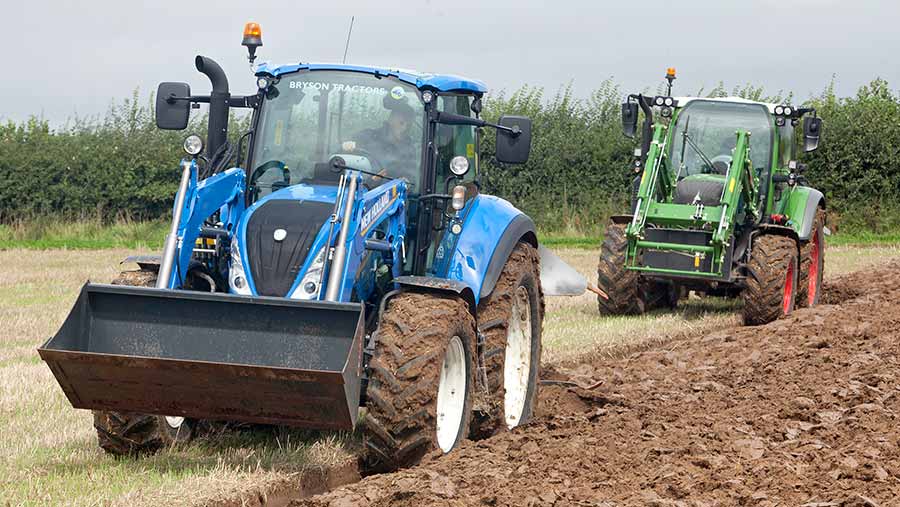
© Jonathan Page
It’s a horsepower sector in which New Holland has traditionally been strong in the UK. The T5 has always been one of its strongest sellers, whereas up until recently Fendt was a very small fish in the sub-150hp pond.
However, the company has reported a surge in sales of its 300 models – up from 12 units in 2012 to 80 machines last year.
Specs: Fendt 312 Vario
- Engine 4.4-litre Agco Power four-cyl
- Power 123hp
- Transmission Vario (CVT)
- Rear lift capacity 5,960kg
- Weight 4,970kg
- Top speed 40kph
- Front tyres 480/65 R24
- Rear tyres 540/65 R38
- Hydraulic pump flow 110-litres/min
- Fuel tank 210 litres
- Retail price £131,000
Engine
The Fendt has the slightly bigger four-cylinder block of the two, with its Agco 4.4-litre having the edge in both capacity and power over the 3.4-litre FPT in the New Holland.
On tick-over, the Fendt offered up a smooth, refined sound, while its rival was louder, lumpier and more intrusive, meaning the radio had to be put a couple of notches up to hear Steve Wright’s Serious Jockin’.
That said, it seemed to better put that power to the ground when pulling a four-furrow plough in the field.
The near-identical brace of Ovlac implements – one having slatted boards and the other standard – provided a stiff test through heavier clay patches.
However, the New Holland wilted less often than its rival and often pulled away from the bigger-engined Fendt on longer runs. But when we did hit a sticky patch, the Vario gearbox was quicker to react to trouble.
Comparatively, if the NH dropped into the 1,200-1,400 rev bracket, the train-like pulling power between 1,600-1,900rpm all but vanished, leaving the driver frantically reaching for one of the buttons to drop down a couple of cogs before it conked out.
Specs: New Holland T5.120
- Engine 3.4-litre Fiat four-cyl
- Power 117hp
- Transmission 16×16 electro command – four range semi powershift with auto function
- Rear lift capacity 5,429kg
- Weight 4,550kg
- Top speed 40kph
- Front tyres 440/65 R28
- Rear tyres 540/65 R38
- Hydraulic pump flow 84 litres/min
- Fuel tank 165 litres
- Price £77,046
Transmission
Probably the biggest difference between the two machines, apart from the alarming price mismatch, is the type of transmission they employ.
Fendt uses its time-proven Vario box in every one of its wheeled machines from 100-500hp, whereas New Holland has stuck with the trusty semi-powershifter, with CVT options available in the T6 range and above.
Pulling a four-furrow plough about 8in deep wasn’t an issue for either of the tractors, and clicking up through the gears in the NH via one of the three handily located shifting buttons was smoother than we initially imagined.
In total there are 16 speeds and a high/low splitter, which resides in a different postcode to the driver’s seat and means it’s a real reach to shove it into the high range even for a 6ft driver.
In the green machine, the Vario gearbox was as smooth as you would expect.
After driving both machines for a couple of days, it’s fair to say the old criticism of Fendt machines being too complicated really has been put to bed, as it was noticeably the simpler of the two to use.
Although it didn’t seem to have the top-end power of the NH, the Vario box managed to adapt smoothly and quickly to changing conditions and left the operator plenty of spare time to concentrate on what the plough was doing.
Cab
The quality of the cab layout, fixtures and fittings is noticeably different. The Fendt is light and roomy, with well-laid-out controls and is almost as nice as the 1000-series, which is its superior by 400hp.
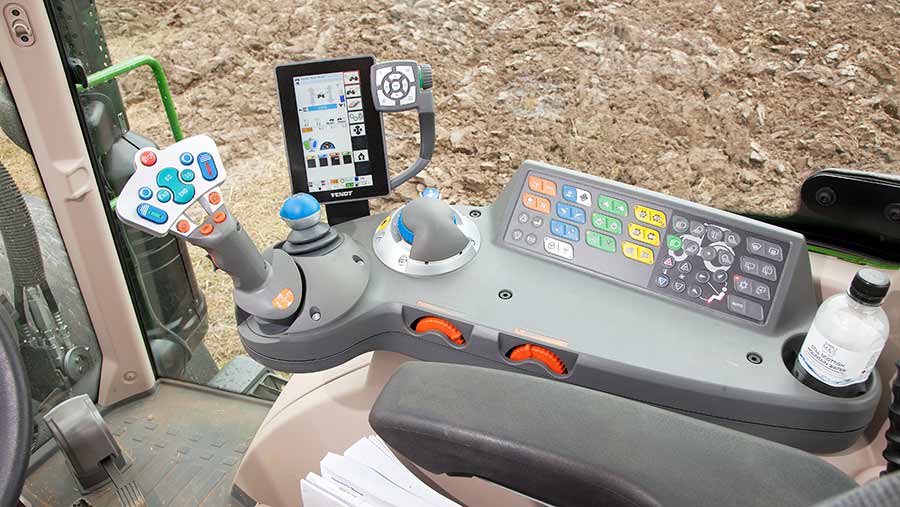
Fendt interior © Jonathan Page
However, it was let down by mounting the controls on the side console, rather than the armrest position of the larger models. This means that as you bounce around in the seat, it’s hard to keep a steady hand on the joystick.
The seat base was also too short for anyone much more than 5ft tall and the open screw heads on show left us feeling like the quality of finish was a fraction short of the bigger machines.
Choosing the top-range Profi-Plus specification offers up guidance capabilities and the 7in touchscreen housing all tractor functions and information.
This makes changing settings far easier than non-Fendt users might think, and it’s fair to say the brand has built up a slightly unfair reputation for complexity.
In stark contrast, the New Holland’s cab was awkward to access via some angled steps and the living space felt smaller than the Fendt, emphasised by the cheaper plastics and six boxy pillars.
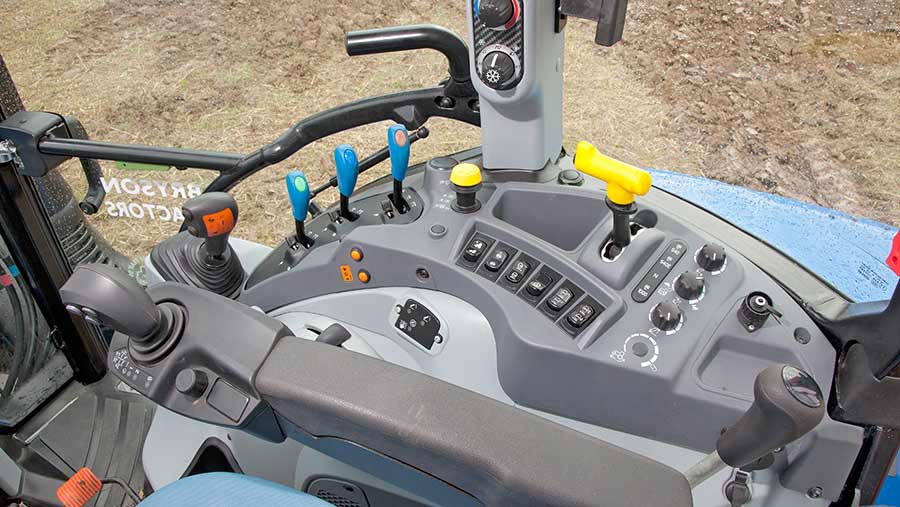
New Holland interior © Jonathan Page
New Holland T5.120
Likes
- Strong pulling power
- Armrest-mounted loader joystick
- Lots of powershift button options
- Smooth shifting under load
Gripes
- Noisy
- Gives up easily below 1,400rpm
- Small-feeling cab
- Winky in-cab computer
It also comes with a rather winky screen mounted in the centre of the dashboard, which stores very basic tractor information.
It also made it far more difficult to adjust any settings and monitor information.
As for passengers, the Germans offer a decent second seat with plenty of space, while drivers and co-pilots will find themselves clashing knees in the New Holland.
Loader
Surprisingly, the New Holland wins in the loader department.
The electric joystick is mounted on the right-hand armrest, which falls into the hand comfortably and has thumb-positioned auxiliary controls along with gear shifters on the rear for finger operation.
While the Fendt also has electronic controls, they are mounted further away from the operator and don’t move with the seat. Views from the cabs to the front loader were similar.
Fendt uses a one-piece curved glass that extends the full length of the front window and swoops into the roof, doing away with crossbars that obscure vision even at full height.
It’s rival has a slide-back sun visor to reveal the roof window when needed, and so has a narrow bar across the top and means the driver will still have to lean forward to follow the bucket through the lift arc.
Fendt 312
Likes
- Quiet and comfortable
- Transmission reacts quickly to conditions
- Easy access, spacious cab
- Surprisingly simple to use
Gripes
- Loader controls sit on the side console
- Seat base too short
- Transmission neutral position hard to find
Verdict
If a majority of your work is loader-related then the New Holland is probably the better choice.
It’s a little noisier than the Fendt, but you will most likely be paying the Germans a lot more cash for electronic wizardry that you may never use and, at well over £50,000 difference in list price, that’s a lot of money to justify parting with.
There are obvious comparisons to be drawn against the transmissions, but it really comes down to whether you’re dead set on having a CVT or not.
If, on the other hand, long days in the field make up a large portion of the machine’s workload, the Fendt has to be a contender purely for the comfort it brings to the operation.
Features such as headland management also make life pretty easy.
Of course, it will be worth a fair bit more when you come to sell it on, too.
If neither machines are to your taste, we have picked out three alternatives with a few hours on the clock that come in at a fraction of the price of a new model.
If the sky-high list prices are too much to stomach, we have picked out three second-hand options with a few hours on the clock that may tick your box.
Second-hand options |
|||
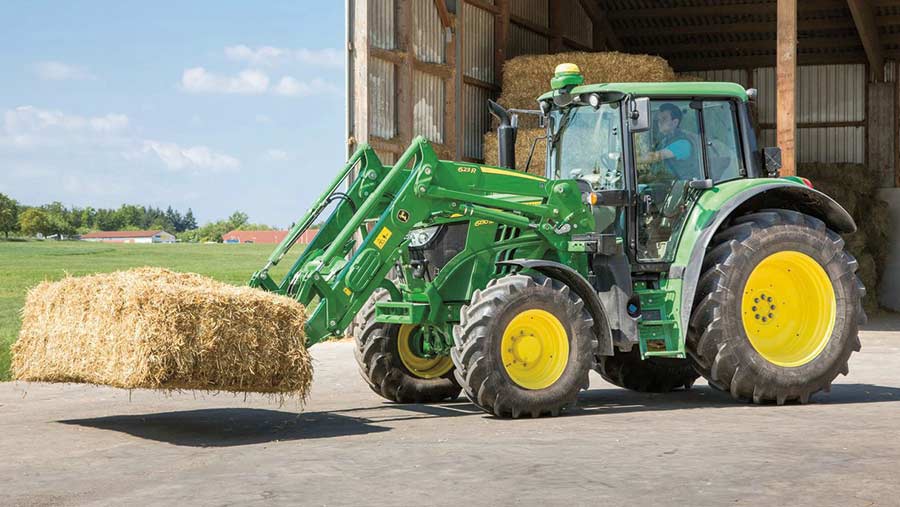 |
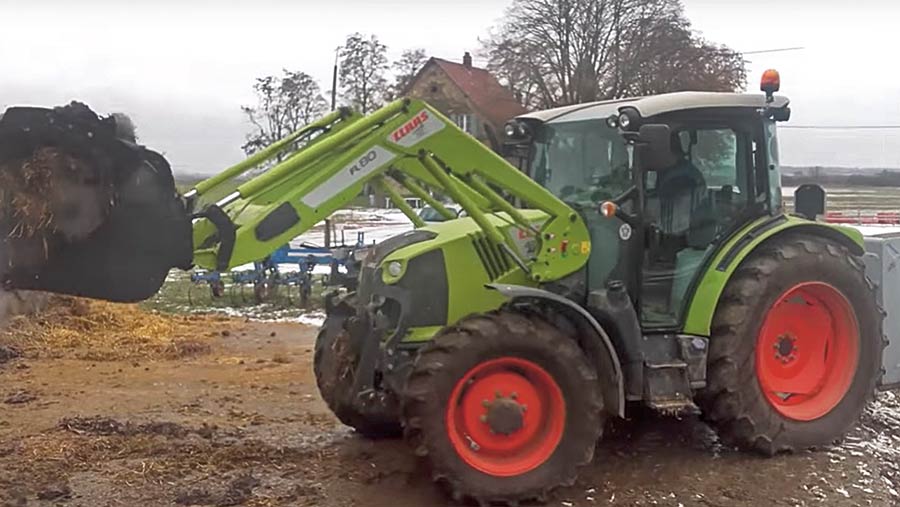 |
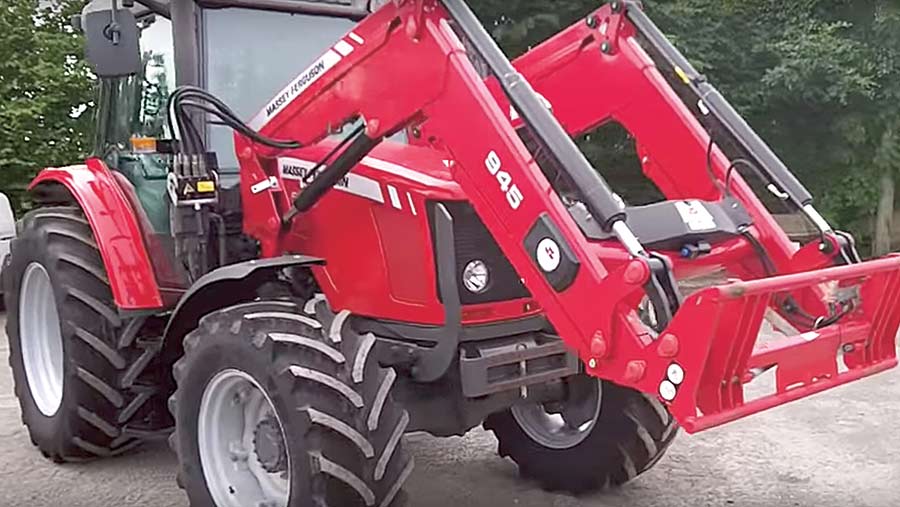 |
|
| John Deere 6120M | Claas Arion 420 | Massey Ferguson 5455 | |
| Year | 2016 | 2015 | 2009 |
| Hours | 1,200 | 1,550 | 3,060 |
| Power | 120hp | 100hp | 110hp |
| Transmission | Semi-powershift | Powershift | Dyna-4 – semi-powershift |
| Loader | Factory fitted | Factory fitted | Quickie Q55 |
| Road speed | 40kph | 40kph | 40kph |
| Price | £52,778 | £44,055 | £29,076 |

